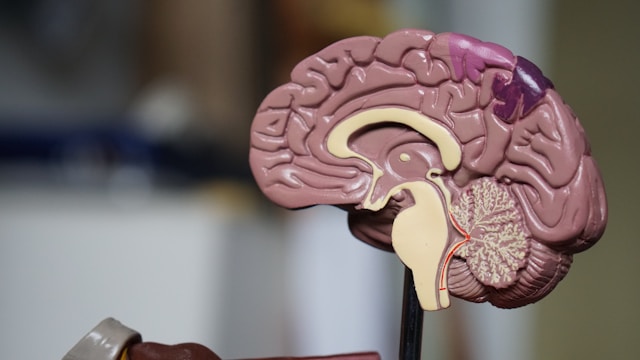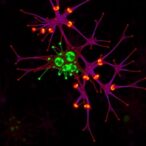
Scientists at the Institute for Basic Science (IBS) have uncovered a non-invasive method to boost the brain’s natural waste drainage system—a discovery that they suggest could open new avenues for tackling age-related neurological disorders.
The team, led by IBS Center for Vascular Research Director Koh Gou Young, MD, PhD, along with senior researchers Jin Hokyung, PhD, Yoon Jin-Hui, PhD, and principal researcher Hong Seon Pyo, PhD, demonstrated in mice that precisely stimulating the lymphatics under skin on the neck and face can significantly enhance the flow of cerebrospinal fluid (CSF)—the liquid that cushions the brain and helps remove toxic waste—through lymphatic vessels.
This, the researchers suggest, offers a new approach to clearing brain waste using safe, non-invasive mechanical stimulation, rather than relying on drugs or surgical interventions. In their published paper in Nature “Increased CSF drainage by non-invasive manipulation of cervical lymphatics,” the team concluded that their findings “… show that the reduction in CSF drainage to cervical lymph nodes in aged mice can be reversed by mechanical stimulation of the skin.” This reversal, they noted, “… points to the potential feasibility of adapting the non-invasive approach for the treatment of patients with neurological conditions accompanied by impaired CSF drainage.”
The human brain produces waste at a high rate compared to other organs, and clearing it efficiently is essential for healthy brain function. This clearance is primarily carried out by CSF, which removes harmful substances such as amyloid-β and tau proteins—key factors in Alzheimer’s and other neurodegenerative diseases. “CSF provides mechanical protection and clears neurotransmitters, metabolites, and amyloid-β, tau and other protein aggregates from the central nervous system,” the authors wrote.
However, as we age, this drainage slows down. Claims that diminished secretion or impaired clearance of CSF can contribute to impaired brain function in aging, Alzheimer disease or other neurodegenerative disorders have promoted interest in gaining a better understanding of factors that regulate CSF outflow, the researchers continued, “…but the underlying pathophysiology and potential approaches for ameliorating these conditions by manipulating CSF drainage are at an early stage of understanding.”
Previous IBS Center for Vascular Research studies had demonstrated that CSF drains to deep cervical lymph nodes via meningeal lymphatic vessels at the base of the skull and the nasopharyngeal lymphatic plexus. They also showed that age-related degeneration of these lymphatics impairs CSF clearance. The team in addition found that CSF drainage could be enhanced or suppressed pharmacologically by targeting cervical lymphatic vessels outside the skull. In their newly released paper, they cited their previous work.
“With the goal of developing approaches for increasing CSF outflow, we found that local pharmacological manipulation of the lymphatics promoted greater CSF outflow,” they stated. However, clinical applications have remained limited because these lymphatics are located too deep in the neck for non-invasive access. “… a limitation was that surgical exposure was required to access these lymphatics located deep in the neck, which were inaccessible to non-invasive approaches for increasing CSF transport by mechanical manipulation through the skin.”
![This diagram shows the pathways cerebrospinal fluid (CSF) takes as it flows from the brain’s surface through facial lymphatic vessels and into lymph nodes in the neck. [Institute for Basic Science]](https://www.genengnews.com/wp-content/uploads/2025/06/low-res-1-208x300.jpeg)
Now, using genetically modified mice and monkeys with fluorescent tracers, the researchers have mapped out a new CSF drainage route from the brain to superficial cervical lymph nodes—via a network of lymphatic vessels in the face, nose, and hard palate. In older animals, many of these routes had degenerated—except for the vessels just beneath the facial skin, which retained full functionality despite aging. “Tracer studies in adult mice revealed that a substantial amount of total CSF outflow to the neck drained to superficial cervical lymph nodes,” they noted. “However, aged mice had fewer lymphatics in the nasal mucosa and hard palate and reduced CSF outflow to cervical lymph nodes.”
Senior researcher and co-first author Jin Hokyung, further explained, “We confirmed that lymphatic vessels beneath facial skin connect to submandibular lymph nodes through various pathways. Through these connections, we can regulate the reduced cerebrospinal fluid drainage function seen in aging and neurodegenerative diseases. Further research is needed to determine how this newly identified pathway can be applied in actual patients.”
![Monkey photos: Images show how cerebrospinal fluid (CSF), labeled with a fluorescent tracer, travels through lymphatic vessels around the eyes, nasal area, hard palate, and neck following infusion into the brain. [Institute for Basic Science]](https://www.genengnews.com/wp-content/uploads/2025/06/low-res-208x300.webp)
Recognizing this, the team developed a force-regulated mechanical stimulator—a handheld device that gently presses and strokes the skin in a controlled manner. When applied to aged mice, the device restored CSF clearance to youthful levels, dramatically improving drainage without disrupting natural lymphatic contractions. “Manipulation of superficial cervical lymphatics through intact skin by a force-regulated mechanical device doubled CSF outflow and corrected drainage impairment in aged mice,” they stated. “This manipulation increased CSF outflow by compressing superficial cervical lymphatics while having little effect on their normal spontaneous contractions.”
The researchers suggest that the technique could pave the way for wearable or clinical devices that enhance brain waste clearance in older adults or patients with neurological conditions. “Overall, the findings highlight the importance of superficial cervical lymphatics for CSF outflow and the potential for reversing CSF drainage impairment by non-invasive mechanical stimulation,” they wrote. “These findings show the feasibility of doubling CSF drainage to superficial cervical lymph nodes by non-invasive, force-regulated, mechanical stimulation of the skin of the face and neck for 20 min.” The team is now investigating how this drainage system behaves in diseases like Alzheimer’s—and whether mechanical stimulation could serve as a preventive or therapeutic tool.
The authors acknowledged that questions do need to be addressed before clinical studies of low-magnitude mechanical transdermal stimulation could be considered. “Among these is why CSF clearance through lymphatics is impaired in aging, traumatic brain injury and other neurological conditions,” they pointed out. “Also to be determined is whether mechanical stimulation of the facial and neck skin daily over more than four days can sustain the increase in CSF outflow in aging and chronic neurodegenerative conditions.”
“I am pleased that we found a safer and more effective method to enhance cerebrospinal fluid drainage from outside the skull,” said neurovascular physiologist and co-first author Yoon Jin-Hui. “We are conducting follow-up studies to investigate how this newly identified drainage pathway is altered in various brain disease patients and how this new stimulation method can be applied therapeutically.”
Added corresponding author Koh Gou Young, “This research not only completed the map of cerebrospinal fluid drainage pathways that clear brain waste but also provided a new method to enhance CSF drainage from outside the brain. We expect this will serve as a milestone for future research on neurodegenerative diseases including dementia.”



